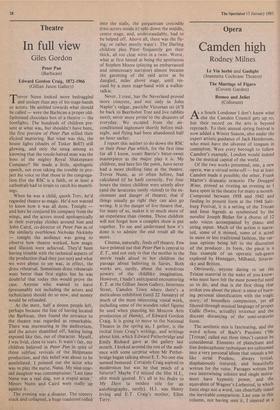Theatre
In full view
Giles Gordon
Peter Pan (Barbican) Edward Gordon Craig, 1872-1966 (Gillian Jason Gallery)
Trevor Nunn looked more bedraggled and unslept than any of his stage-hands or actors. He ambled towards what should be called — were the Barbican a proper old- fashioned chocolate box of a theatre — the footlights, The hundreds of children pre- sent at what was, but shouldn't have been, the first preview of Peter Pan stilled their excited muttering. But what was this, the house lights (shades of Tinker Bell?) still glowing, and only the smug among us knowing that the tousle-haired man was the boss of the mighty Royal Shakespeare Company? He made a little, apologetic speech, not even taking the trouble to pro- ject his voice so that those in the congrega- tion (for the RSC is a faith, or at least a cathedral) had to strain to catch his mumbl- ings.
When he was a child, quoth Trey, he'd regarded theatre as magic. He'd not wanted to know how it was all done. Tonight and here he conjured his company from the wings, and the actors stood apologetically in their everyday clothes around him and John Caird, co-director of Peter Pan as of the similarly overblown Nicholas Nickleby — tonight the audience was going to observe how theatre worked, how magic and illusion were achieved. They'd been having trouble with the technical aspects of the production (had they just not) and what we were about to see was, in effect, the dress rehearsal. Sometimes dress rehearsals went better than first nights but he was doubtful that today this would prove the case. Anyone who wanted to leave (presumably not including the actors and technicians) should do so now, and money would be refunded.
At the most, half a dozen people left, perhaps because the feat of having located the Barbican, then found the entrance to the theatre was regarded as remarkable. There was murmuring in the auditorium, and the actors shambled off, hating being exposed like this, out of character. Myself, I was livid, close to tears. It wasn't fair, my children believed in Peter Pan in spite of those subfuse revivals of the Helpmann production, and this belief was about to be annihilated. I pointed out the actor who was to play the nurse, Nana. My nine-year- old daughter was contemptuous: 'Last time Nana was a real dog, not a stupid actor.' Messrs Nunn and Caird were really up against it.
The evening was a disaster. The scenery stuck and collapsed, a huge toadstool rolled into the stalls, the gargantuan crocodile (two actors inside it) split down the middle, centre stage, and, understandably, had to be helped off. Above all, there was the fly- ing, or rather mostly wasn't. The Darling children plus Peter frequently got their thick, all too clear wires in a twist. Worst, what at first hinted at being the apotheosis of Stephen Moore (playing an embarrassed and unnecessary narrator) almost became the garotting of the said actor as he dangled, miles above stage, until res- cued by a stern stage-hand with a walkie- talkie.
Never, I trust, has the Neverland proved more concrete, and not only in John Napier's vulgar, pastiche Victorian set (it'll be back to Beerbohm Tree and live rabbits next); never more prone'to the disasters of everyday. We escaped from the air- conditioned nightmare shortly before mid- night, and flying had been abandoned half an hour earlier.
I report this neither to do down the RSC or their Peter Pan which, for the first time for all I know, treats Barrie's bitter-sweet masterpiece as the major play it is. My children, and here lies the point, have never had a more thrilling time at the theatre. Trevor Nunn, as so often before, had calculated (if he had) correctly. For four hours the tiniest children were utterly alive (and the lavatories rarely visited) to the ex- citement and danger of theatre; that if things usually go right they can also go wrong. It is the danger of live theatre that, for many of us, makes it so much more of an experience than cinema. Those children will not forget how a complex show is put together. To see and understand how it's done is to admire the end result all the more.
Cinema, naturally, feeds off theatre. Few have pointed out that Peter Pan is central to E.T., and not only in that the mother in the movie reads aloud to her children the passage about believing in fairies. Both works are, surely, about the wondrous powers of the childlike imagination. However, I hadn't anticipated encountering E.T. at the Gillian Jason Gallery, Inverness Street, Camden Town where there's a meticulous exhibition (until 22 January) of much of the most interesting visual work, including some of the wooden relief figures he used when planning his Moscow Arts production of Hamlet, of Edward Gordon Craig. It is going to move to the National Theatre in the spring as, I gather, is the recital from Craig's writings, and writings about him, which Edward Petherbridge and Emily Richard gave at the gallery last month. I looked around the rest of the audi- ence with some surprise when Mr Pether- bridge began talking about E.T. No one else seemed bemused. Certainly Craig aspired to modernism but was he that much of a futurist? Maybe I'd missed the film H.I., also much quoted. It's all in his Index to My Days (a modest title for an autobiography, surely). H.I. was Henry Irving and E.T. Craig's mother, Ellen Terry.






































 Previous page
Previous page